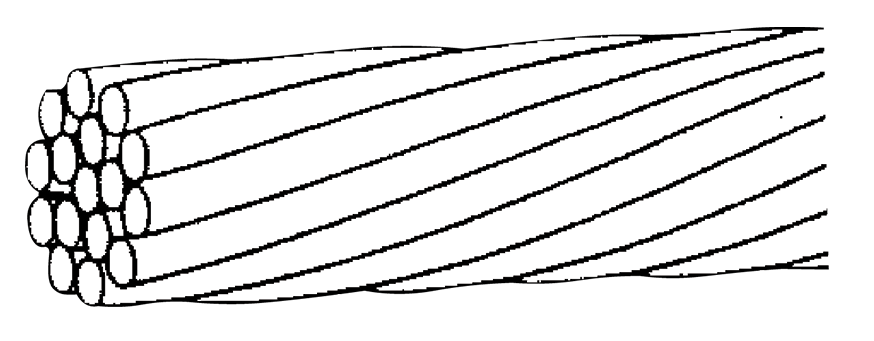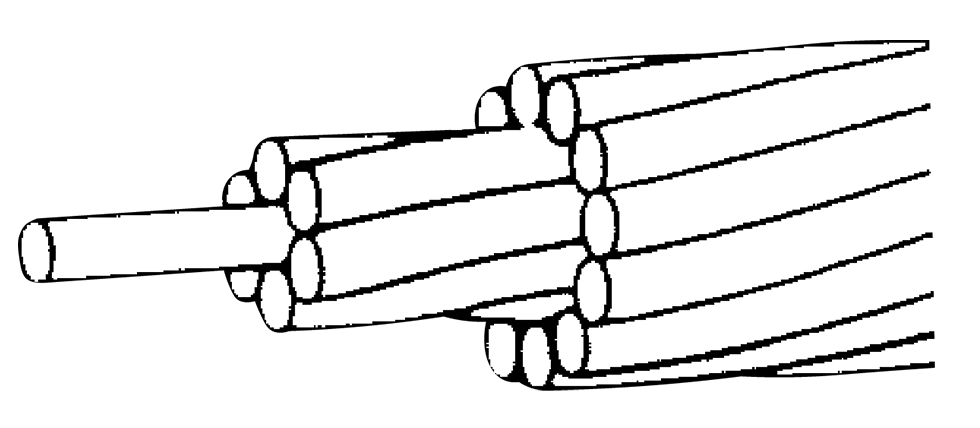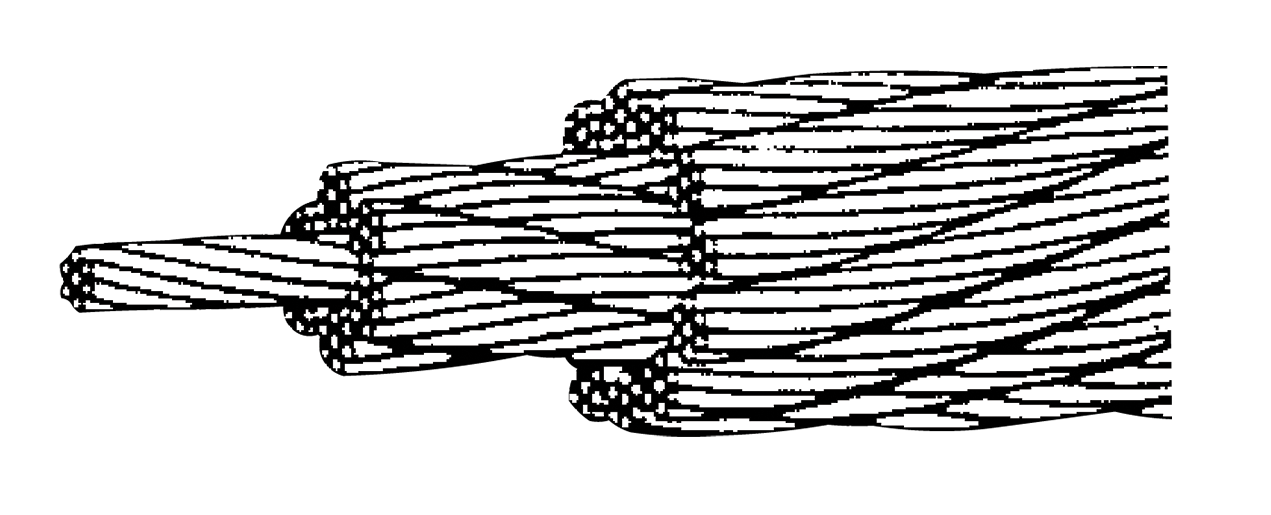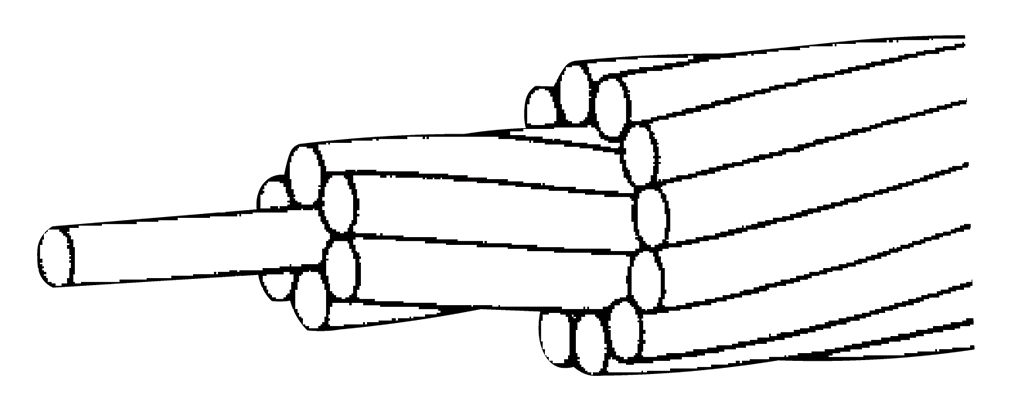Conductor Stranding Constructions
Different Types of Conductor Strandings
| Bunch Stranding | Unidirectional Concentric Unilay Stranding |
 |
 |
| Rope Stranding | Concentric Equilay Stranding |
 |
 |
|
Bunch Stranding: This type of stranding has any number of strands bunched together and twisted in the same direction. This is a reliable construction but doesn't have as high-quality extrusion as other constructions. This method is the lowest costing or cheapest type of stranding that's currently available. A similar construction called smooth bunch stranding has helped solve major issues by arranging the strands in a geometric configuration. |
| Unidirectional Concentric: This stranding configuration has multiple layers of helically laid strands with the same direction of lay. The lay lengths also increase with every succeeding layer. |
| Unilay: This stranding configuration has multiple layers of helically laid strands with the same direction of lay. This stranding also has the same lay length as all succeeding layers. |
| True Concentric: A single central strand that is surrounded by layers of helically laid strands. Every layer has a reversed lay direction with increasing lay lengths for every succeeding layer. |
| Equilay: A single central strand that is surrounded by layers of helically laid strands. Every layer has a reversed lay direction with the same lay lengths for every layer. |
| Rope: A rope standing is any type of stranding (Bunch, Unicentric, etc.) grounded into a large cable. This construction is used in order to create a very flexible conductor. |
Stranding Class Uses |
|
| Concentric-lay Conductors | |
| Class B | Power cables. |
| Class C | Power Cables where more flexible stranding than B class is required. |
| Class D | Extra flexible stranding, typically used in power cables. |
| Rope-lay & Bunch stranded Conductors | |
| Class G | All types of portable cables. |
| Class H | Any cable where extreme flexibility is essential. |
| Class I | Motor leads and apparatus cables. |
| Class K | Stationary service cables composed of 30 AWG copper wires. |
| Class M | Constant service cables composed of 34 AWG copper wire. |
Copper Conductor & Stranding Data
| Concentric Strand | Rope Lay | |||||||||||
| - | Bunch Strand | |||||||||||
| Approx. O.D. |
Pounds /1000 ft |
Circular Mils |
Size AWG /CM |
Class AA | Class A | Class B | Class C | Class D | Class G | Class H | Class K30 AWG (0.010”) | Class M34 AWG (0.0063”) |
| 0.0050 | 0.0757 | 25.00 | 36 | |||||||||
| 0.0056 | 0.0954 | 31.52 | 35 | |||||||||
| 0.0063 | 0.1203 | 39.75 | 34 | |||||||||
| 0.0071 | 0.1517 | 50.13 | 33 | |||||||||
| 0.0080 | 0.1913 | 63.21 | 32 | |||||||||
| 0.0089 | 0.2413 | 79.70 | 31 | |||||||||
| 0.0100 | 0.3042 | 100.5 | 30 | |||||||||
| 0.0113 | 0.3836 | 126.7 | 29 | |||||||||
| 0.0126 | 0.4837 | 159.8 | 28 | |||||||||
| 0.0142 | 0.6100 | 201.5 | 27 | |||||||||
| 0.0159 | 0.7692 | 254.1 | 26 | |||||||||
| 0.0179 | 0.9699 | 320.4 | 25 | |||||||||
| 0.0201 | 1.2230 | 404.0 | 24 | |||||||||
| 0.0226 | 1.5420 | 509.5 | 23 | |||||||||
| 0.0254 | 1.9450 | 642.4 | 22 | |||||||||
| 0.0285 | 2.4520 | 810.1 | 21 | |||||||||
| 0.0363 | 3.1540 | 1,020 | 20 | 7 | 19 | 10 | 26 | |||||
| 0.0456 | 5.0150 | 1,620 | 18 | 7 | 19 | 16 | 41 | |||||
| 0.0576 | 7.9740 | 2,580 | 16 | 7 | 19 | 26 | 65 | |||||
| 0.0726 | 12.680 | 4,110 | 14 | 7 | 19 | 37 | 49 | 41 | 104 | |||
| 0.0915 | 20.160 | 6,530 | 12 | 7 | 19 | 37 | 49 | 65 | 168 | |||
| 0.1160 | 32.060 | 10,380 | 10 | 7 | 19 | 37 | 49 | 104 | 259 | |||
| 0.1600 | 40.420 | 13,090 | 9 | 7 | 19 | 37 | 49 | 133 | ||||
| 0.1460 | 51.000 | 16,510 | 8 | 7 | 19 | 37 | 49 | 133 | 168 | 420 | ||
| 0.1840 | 80.900 | 26,240 | 6 | 7 | 19 | 37 | 49 | 133 | 266 | 665 | ||
| 0.2320 | 129.00 | 41,740 | 4 | 3 | 7 | 7 | 19 | 37 | 49 | 133 | 420 | 1,064 |
| 0.2600 | 162.00 | 52,620 | 3 | 3 | 7 | 7 | 19 | 37 | 49 | 133 | 532 | 1,323 |
| 0.2990 | 205.00 | 66,630 | 2 | 3 | 7 | 7 | 19 | 37 | 49 | 133 | 665 | 1,666 |
| 0.3320 | 259.00 | 83,690 | 1 | 3 | 7 | 19 | 37 | 61 | 133 | 259 | 836 | 2,107 |
| 0.3730 | 326.00 | 105,600 | 1/0 | 7 | 7 | 19 | 37 | 61 | 133 | 259 | 1,064 | 2,646 |
| 0.4190 | 411.00 | 133,100 | 2/0 | 7 | 7 | 19 | 37 | 61 | 133 | 259 | 1,323 | 3,325 |
| 0.4700 | 518.00 | 167,800 | 3/0 | 7 | 7 | 19 | 37 | 61 | 133 | 259 | 1,666 | 4,256 |
| 0.5280 | 653.00 | 211,600 | 4/0 | 7 | 7 | 19 | 37 | 61 | 133 | 259 | 2,107 | 5,320 |
| 0.5750 | 772.00 | 250,000 | 250,000 | 12 | 19 | 37 | 61 | 91 | 259 | 427 | 2,499 | 6,384 |
| 0.6300 | 925.00 | 300,000 | 300,000 | 12 | 19 | 37 | 61 | 91 | 259 | 427 | 2,989 | 7,581 |
| 0.6810 | 1080.0 | 350,000 | 350,000 | 12 | 19 | 37 | 61 | 91 | 259 | 427 | 3,458 | 8,806 |
| 0.7280 | 1236.0 | 400,000 | 400,000 | 19 | 19 | 37 | 61 | 91 | 259 | 427 | 3,990 | 10,101 |
| 0.8130 | 1542.0 | 500,000 | 500,000 | 19 | 37 | 37 | 61 | 91 | 259 | 427 | 5,054 | 12,691 |
| 0.8930 | 1850.0 | 600,000 | 600,000 | 37 | 37 | 61 | 91 | 127 | 427 | 703 | 5,985 | 14,945 |
| 0.9980 | 2316.0 | 750,000 | 750,000 | 37 | 61 | 61 | 91 | 127 | 427 | 703 | 7,581 | 18,788 |
| 1.1520 | 3086.0 | 1,000,000 | 1,000,000 | 37 | 61 | 61 | 91 | 127 | 427 | 703 | 10,101 | 25,193 |
